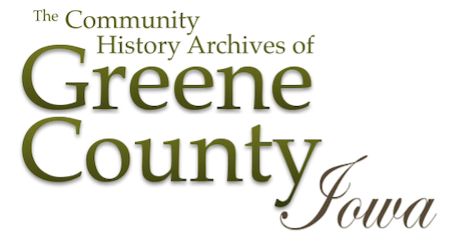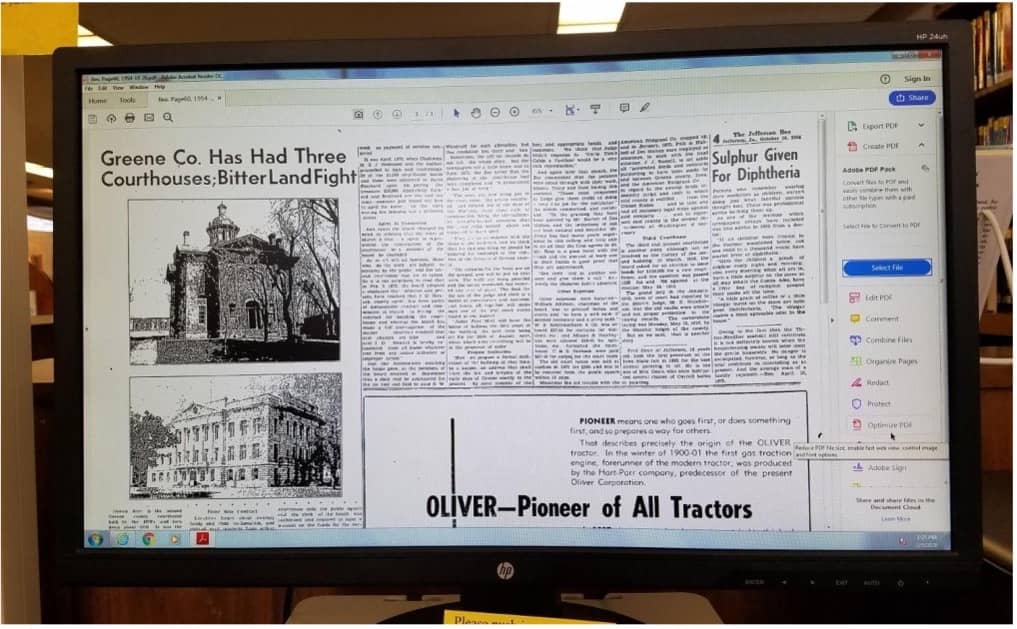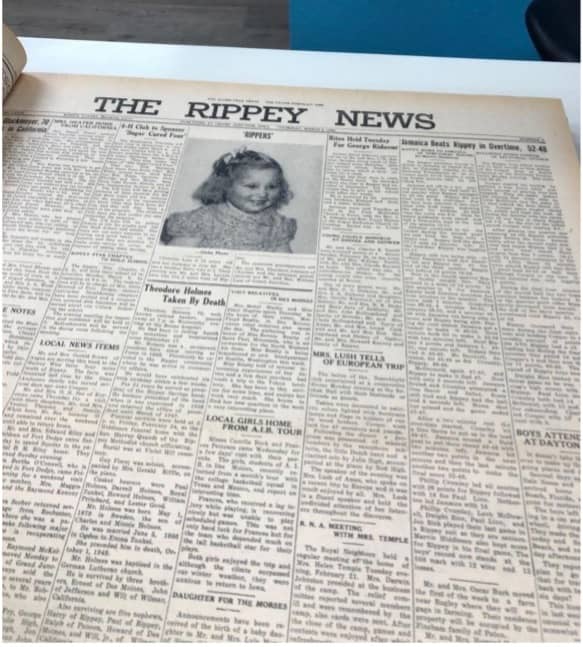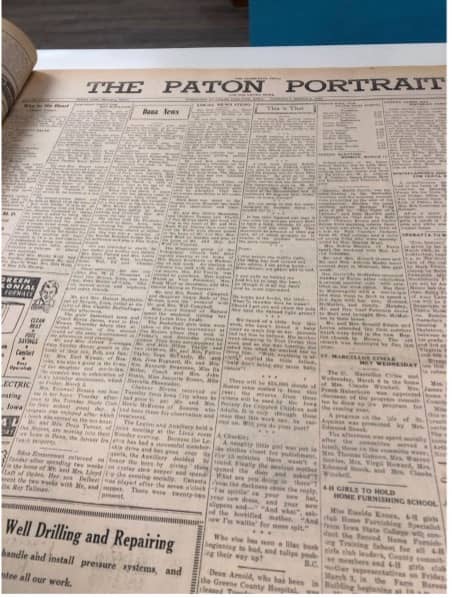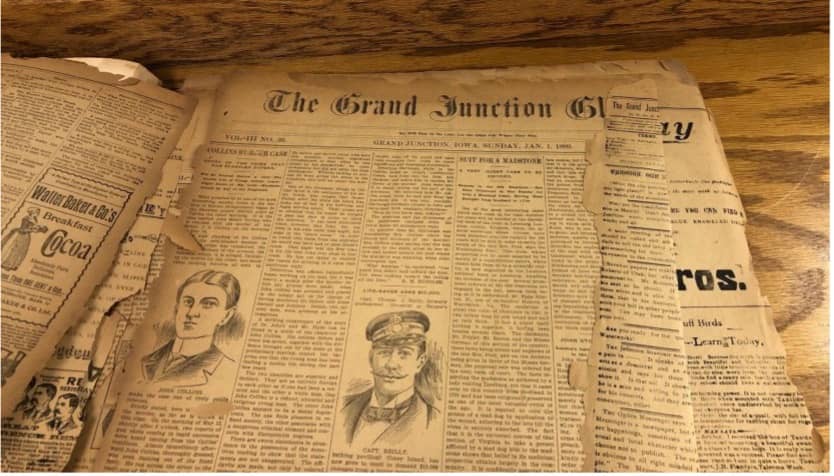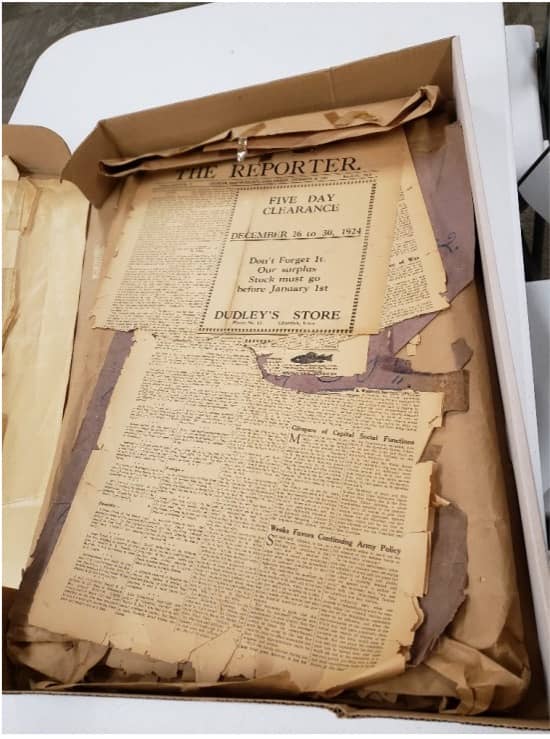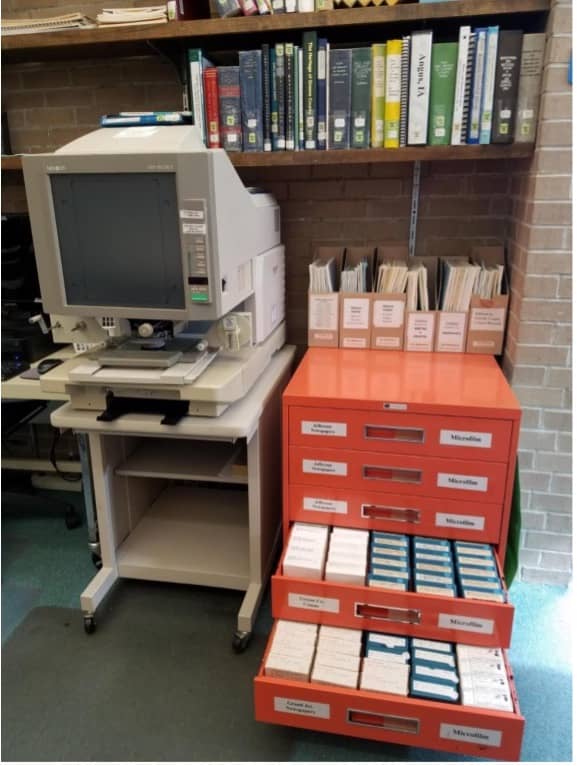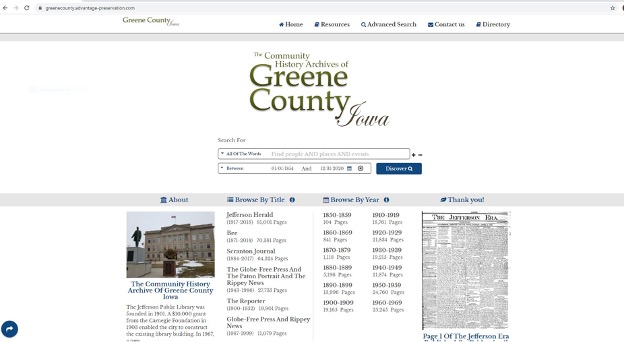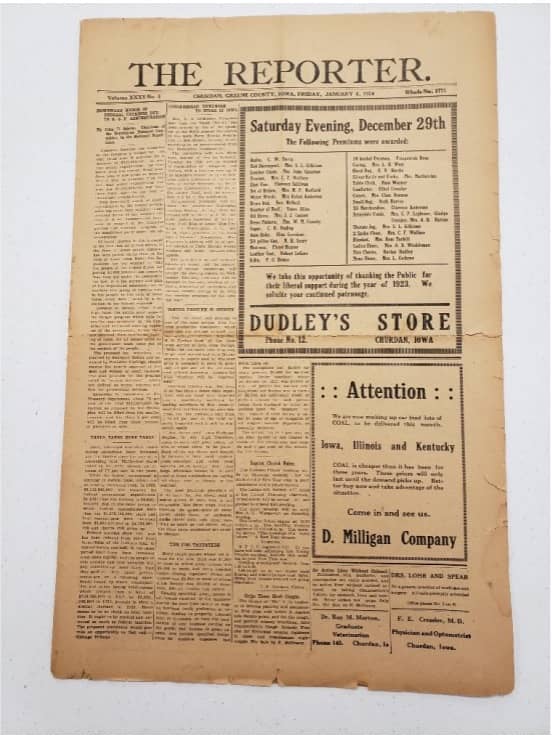The Community History Archives Of Greene County, Iowa

The Greene County Librarians Association has made researching Greene County’s history easy! Their Community History Archive is free, easy to use, and offers a wide variety of historical resources representing all areas of the county.
Greene County’s rich history spans over 175 years, dating back to 1849 when Truman Davis first settled in the area. He chose a spot close to the present town of Rippey, Iowa near the Raccoon River (just South of Squirrel Hollow). Only five years later, in 1854, Greene County was officially organized, and two years after that, the first courthouse was built in Jefferson. The courthouse marked a milestone… because, before 1856, Judge Phillips held court in a log cabin located southeast of Jefferson, Iowa.
Now, Greene County’s past is being brought to the present via their Community History Archive. Serving as a “portal to the past”, Greene County’s digital archives allow for free and open access to newspapers and other historical resources. This allows us to explore the stories of the people, places, and events that helped shape Greene County, viewed through the lens of those who were there, and recorded in their words.
Like the story of Captain Darrell Lindsey. Captain Lindsey was a World War II Congressional Medal of Honor recipient whose B-26 airplane took a direct hit. By his skillful maneuvering, the crew was able to parachute to safety. Captain Lindsey went down with his aircraft on his 46th bombing mission. The team at Advantage is excited to be a part of the GCLA’s efforts to provide their community with an easy way to connect with stories like Captain Lindsey’s.
In addition to discovering elements of Greene County’s past, the archive can also be used by those with ties to the area as a way to connect with their own personal history. Through birth and marriage announcements, death notices and obituaries, community events, scholastic and athletic achievements, they can stitch together the story of where they come from.
For those of us with deep roots in Greene County, this archive is like finding buried treasure. I’ve been researching my family’s Greene County roots for over 40 years and have been able to uncover tidbits that I never knew about my family
With the Greene County Community History Archive, genealogists have gained a powerful research tool. The Greene County Genealogical Society (GCGS) was pleased to support the expansion of the archive.
People will find so much more information to help them with their family history research now
The effort to make Greene County’s history accessible began in 2012 when the Jefferson Public Library converted 150 years of Jefferson newspapers from microfilm to digital images, making them available to search on an Internet website.
The archive has now been expanded to include newspapers from Churdan, Grand Junction, and Scranton plus many other Greene County historical resources. Rippey and Paton newspapers are included in the Grand Junction newspapers, as well as articles about Dana. Cooper and Farlin news are included in the Jefferson newspapers.
Newspapers preserve the history of our communities. We have had very consistent usage of the Jefferson newspaper archive… and statistics also show usage from all other states and many other countries. We have always wanted to expand this resource to include resources that represent the history of the whole county,
Millard was excited two years ago when three other libraries expressed interest in digitizing their town newspapers. She presented the idea of expanding the digital archive as a collaborative project at the next GCLA meeting. Millard suggested that they digitize even more historical resources beyond the county newspapers if they could raise enough funds.
The librarians got right to work doing fundraising in their communities. With assistance from the Greene County Genealogical Society (GCGS), the librarians put together a list of important county historical resources. Writing a grant to the Greene County Community Foundation was the next step. The project was funded by a Greene County Community Foundation grant and donations from the Greene County Board of Supervisors’ Louis Dreyfus Fund, the Greene County Genealogical Society, The Scranton Journal, The Scranton Public Library Foundation, State funds for libraries, memorial gifts, and donations from private individuals.
The Grand Junction library held a bake sale, and Scranton raised over $1,000 at a community fundraising event.
Now anyone wishing to do research on historical happenings in Greene County can find articles of interest about places such as county landmarks, parks or businesses, events such as sports, weddings, festivals, or weather, or people such as awards, interviews, ancestors, obituaries, and family reunions.
The Editor of The Scranton Journal was just one of many that were very pleased to see this project come together.
This project has been on my personal bucket list for years. The bound copies dating back to the 1880s are so fragile, they were literally falling apart and we couldn’t allow anyone to use them. Now with the newspapers searchable online, our history is preserved in a digital format that won’t crumble or be lost,
Everyone involved in the project knows that digitizing their microfilm holdings and other documents of historical interest, will unlock history by bringing it out of the drawer and put it at their community’s fingertips.

Librarians and genealogy volunteers met with Jeff Brown from Advantage Preservation in the fall of 2019 to select various other printed materials of historic and genealogical value to preserve and make more widely accessible for research through digitizing the records and adding them to the archives website.
It goes without saying, but physical newspapers, either loose or in bound volumes, are at risk. Paper is not permanent nor stable. Some newspapers printed in the early 1900s are brittle and fragile. Depending on the condition, even turning a page can sometimes “snap” a page in half, or leave part of the page in your hand.
Oddly enough, sometimes the older the newspaper, the better the condition you will find it. Many pages published until the late 1800s were published on paper stock with a large percentage of cotton fabric. While these “rag” papers are more resistant to damage with the passage of time, they are also more susceptible to contamination from oils on the skin, leading to discoloration and fading of the print.
Once mass production of newspapers had begun, and it coincided with the development of a new paper-making technique based on pulping wood. By 1870, wood pulp had completely replaced rags as the main ingredient in producing paper. This innovation allowed paper production to finally keep pace with the increased rate at which newspapers were printed.
The demand for the paper on which to print the news inevitably grew as well. This created a need to use a less expensive paper stock to match the increased production rates. This ushered in the era of “newsprint” paper. The inexpensive, machine-produced, non-archival paper consisted mainly of wood pulp. Newsprint was seen as a disposable medium. The readily available and inexpensive paper-stock was used with the view that the newspaper discarded immediately after viewing.
A publisher that printed a paper in 1850 had no reason to believe that those pages might be around 200 years after they came off the press. This is why many libraries, publications, and repositories find themselves in a race against time, with print volumes that are rapidly deteriorating.
Those institutions know that many of the papers in their collection couldn’t be replaced if they were lost or damaged. Some have been forced to limit public access to their print materials due to their fragile condition. In addition, humidity, temperature variations, and other environmental factors also accelerate the degradation of the paper adding a sense of urgency.
The libraries of Greene County recognized this and took steps so that the history recorded on paper would not be lost, and would be available to read for the generations to read and learn from.
Knowing that paper deteriorates, ink fades, and the physical copies will eventually succumb to the ravages of time, they did not want to risk losing the accounts recorded in print. However, the concerns do not begin and end with paper.
Most newspaper digitization projects are done from the community’s microfilm collection. While microfilm has been (and likely always will be) the “gold standard” for long term preservation, it too presents some unique challenges, not the least of which is the fact that by the time that some of the most valuable newspaper pages are filmed for preservation purposes, they had already deteriorated to an illegible state.
Microfilm is a stable, archival form when properly processed and stored. Preservation standard microfilms use the silver halide process, which creates silver images in hard gelatin emulsion on a polyester base. With appropriate storage conditions, this film has a life expectancy of 500 years.
Unfortunately, until the late 1970s, many of these collections were stored on shelves and exposed to humidity and temperature variations that caused instability in the gelatin used to bind the silver halide. This is why maintaining the master microfilm in a climate-controlled environment is so important.
The other issue with microfilm? While it is a fantastic preservation strategy…it makes for a lousy research tool. Digitizing those reels takes history out of the drawer and puts it at the fingertips of the residents of Greene County (and beyond).
Researching digitally is not only a more efficient way of searching, it also helps further preserve the original documents and microfilm from deteriorating from further handling.
Unlike a microfilm reader, a digital archive is available to multiple local users, anyone with an internet connection can access the digital archive free of charge. This allows the libraries of Greene County to extend their reach beyond the walls of their institution.
We had years of old newspapers stored under the counters. They were difficult to access and in very fragile condition. Now we can find everything easily on the computer without handling any of the newspapers,” !
The Community History Archive platform is designed to be powerful, but not intimidating. It needs to be friendly, intuitive, and easy to learn. Advantage has focused on making it as simple as possible so that everyone…from students to grandparents (and everyone in between) can browse, search, view, clip, and share articles, headlines, pages, and stories recorded in the pages of the community newspaper.
Just type a search and hit “enter” or browse to a specific year, month, day, or page in any (or all) publications contained in the archive.
Searching for information on the archive website is similar to searching for information on Google. Enter a name or keyword in the search field, and all the instances that name or keyword appears in all of these resources will be listed as search results. You can narrow down the results by date and resource and also print, email or save the articles you find!
Some libraries use their archives as an engagement or outreach tool to connect with their communities in new and exciting ways. Most libraries and institutions view the archive as an extension of their other online or remote resources, making more content available to their patrons.
Many communities across the country have begun encouraging their educators to use their Community History Archives in their lesson plans when teaching American history.
By using local primary source materials when researching national or international events, it can become a more “tangible” learning experience. A student can connect with how the community reacted to certain events, and how those events shaped not only the nation but also their own community specifically.
We think this new website is so easy to use, and our county school teachers and students will also find it useful when doing local history projects
While newspapers are the logical place to start, the GCLA knows it is just a foundation that can be built upon. Anything can be added to the archive at any time, including correspondence, journals, atlases, genealogy records, maps, vital statistics, and just about anything else that contains the history of the community.
Other resources in Greene County’s archive include indexes of birth, marriage, and death records, census, and cemetery indexes, church centennial books, military records, an index to biographical sketches of Greene County residents from 1887, articles and memories of the old coal-mining town of Angus, the Grand Junction fire department history, Terrill diaries, Paton, Scranton, and Rippey centennial books, 100 years of memories of Adaza, and several other printed historical resources. The oldest resource on the website is the 1856 Iowa state census of Greene County.
The digital archive will continue to grow. We will add more resources as funding is available
This includes adding another year of recent Jefferson and Scranton newspapers annually.
The Greene County Librarians wish to thank all of their partners and sponsors for their help in making this county-wide historical archive possible. Donations to this project may be left at any of the six libraries in Greene County.
It’s important to preserve our county’s history for future generations
Advantage partners with communities across the United States, just like the ones in Greene County, to archive and provide practical digital access to local historical content in print, that would otherwise be lost to the erosion of time.
We focus on bringing the libraries, local publishers, historical and genealogical societies, educational institutions, and other like-minded individuals together to preserve the community’s past and make it accessible in the present.
We believe strongly in building lasting partnerships, which is why we enter into them with the intent of shouldering our fair share by taking the burden off of the community for the ongoing costs associated with storage, hosting, development, and maintenance of their Community’s History Archive. We are proud to be an active participant in the community’s efforts to make their collective history more accessible.
If you are outside of Greene County and would like to see YOUR local history online, please contact your local library, newspaper publisher, genealogical society, historical society, or educational institution, and encourage them to learn more about creating a Community History Archive like the one the GCLA has created for theirs. Ask them to e-mail us using the form below or have them contact us at (855) 303-2727.

